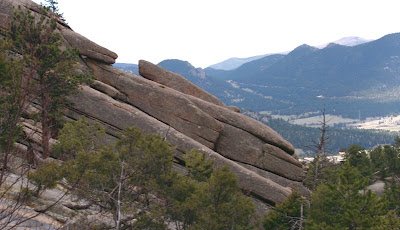Elevation: 7,882 ft - 8,830 ft
Elevation Gain: 948 ft
Gem Lake is one of my favorite hikes in Rocky Mountain National Park. It traverses an unusual igneous rock formation called Lumpy Ridge and reminds me of my youth hiking in the Sierra Nevadas.
 Looking south from the trail. To the left is Twin Sisters, behind the large hill is Estes Cone, and the snow capped peaks are Longs, Meeker, and Mount Lady Washington.
Looking south from the trail. To the left is Twin Sisters, behind the large hill is Estes Cone, and the snow capped peaks are Longs, Meeker, and Mount Lady Washington.The park has changed the trail head for Gem Lake since I last hiked it in 2006. There is a new, paved trailhead (Lumpy Ridge) with a nice bathroom and sign. Both the old and new trailheads are still on Devil's Gulch Road, which is right after the Stanley Hotel (see photo on my Winter RMNP photo shoot). The old trail used to skirt private property and wander by several homes. The new trail has a more natural feel to it and starts out right next to a large igneous boulder field.
Gem Lake is a easy trail, and I will often take new hikers on it because the views are spectacular and the rocks add interest all along the way. Typical of trails in the park, the route is well maintained although towards the end, there is a section of high steps that would trouble someone with knee issues. Most of the trail is sandy with occasional traverses of broad rock plateaus.
Besides the towering rocks, views of Estes Park and the surround peaks are visible from several locations. These would make an ideal al fresco dining spot for those more interested in lingering over a picnic lunch.
 Paul Bunyans' boot. I knew someone that scrambled up this large rock and stuck his head through it. It is larger than you think.
Paul Bunyans' boot. I knew someone that scrambled up this large rock and stuck his head through it. It is larger than you think.Gem Lake itself is more of a pond and not a very spectacular destination. It is surrounded by rocks but compared with other high alpine lakes in the park, just does have the same appeal. It really is the route itself that is the appeal of the Gem Lake trail.
There is a feisty inhabitant of the Gem Lake area and that is the Golden-mantled Ground Squirrel (Spermophilus lateralis). On a trip back in 2004, they were everywhere and were literally climbing into people's packs, climbing up their pant legs etc., all in an attempt to gather morsels of forbidden sandwiches. On this trip we did not see any, but we did not stay at the lake for long either.
The other nice feature of Gem Lake is that it is lower in altitude than other trails so it is suitable for the late fall or early spring. For a longer hike, one can head down the back side of Lumpy Ridge to Balanced Rock. I have done this once and found the trail somewhat monotonous, but since Gem Lake is short, the added excursion will at least give you mileage.
 A Golden-mantled Ground Squirrel taken in 2004. At one point this little gal climbed up into my lap.
A Golden-mantled Ground Squirrel taken in 2004. At one point this little gal climbed up into my lap.If you are visited the park for the first time and live at sea level, I would consider doing Gem Lake as one of your first hikes. It is short, lower in altitude, and the views will give you a perspective on the more traveled southern part of the park.

























































